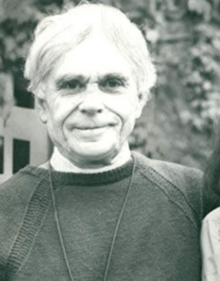Stephen Verney
Stephen Edmund Verney (17 April 1919 – 9 November 2009)[1] was the second Bishop of Repton from 1977 to 1985;[2] and from then on an honorary assistant bishop within the Diocese of Oxford.
Stephen Verney | |
|---|---|
| Bishop of Repton | |
 | |
| Church | Church of England |
| Diocese | Diocese of Derby |
| In office | March 1977 – 1985 |
| Predecessor | Warren Hunt |
| Orders | |
| Ordination | 1950 (deacon) 1951 (priest) by Russell Barry |
| Consecration | 31 March 1977 by Donald Coggan |
| Personal details | |
| Birth name | Stephen Edmund Verney |
| Born | 17 April 1919 |
| Died | November 9, 2009 (aged 90) |
| Nationality | British |
| Denomination | Anglican |
| Parents | Sir Harry Verney, 4th Baronet and Lady Rachel Verney |
| Spouse | Priscilla Schwerdt (m. 1947) – Sandra Bailey (m. 1981) |
| Education | Harrow School |
| Alma mater | Balliol College, Oxford |
The son of Sir Harry Verney, 4th Baronet, he was born on 17 April 1919 and educated at Harrow[3] and Balliol College, Oxford. In 1947 he married Priscilla Schwerdt;[4] he was made deacon at Michaelmas 1950 (1 October), by Russell Barry, Bishop of Southwell, at Southwell Minster,[5] and ordained priest (presumably the next Michaelmas). He began his career with a curacy at Gedling[6] after which he was: Priest in charge of St Francis Clifton, Nottingham; Vicar of Leamington Hastings; Diocesan Missioner for the Diocese of Coventry then finally, before his appointment to the Episcopate, a Canon Residentiary at Windsor. His first wife died in 1974 and seven years later became the first Bishop to marry a divorced woman.[7] He was consecrated a bishop on 31 March 1977, by Donald Coggan, Archbishop of Canterbury at Westminster Abbey.[8] After 8 years as the suffragan bishop in the Diocese of Derby, he retired to Blewbury in 1985.
Verney was active in an organisation called The New Era Centre, which was founded by Dr Fred Blum in 1967. In 1969, Blum met Verney at a conference in Coventry where Verney was doing reconciliation work. They became friends, “like brothers”, and Verney became a trustee and significant supporter and contributor to the creation and work of The New Era Centre, which became a registered charity on 20 December 1979. Verney was a well-connected individual, and frequently communicated with the politician Roy Jenkins. The residential community of The New Era Centre in The Abbey, Sutton Courtenay, which was purchased in 1980, was dedicated on 4 October 1981 as a space to explore and work towards the synthesis of Christianity and more contemporary understandings of societal transformation. In 1984, after The Abbey was improved to a habitable state, the first two resident community members moved in. Stephen Verney extensively discussed, and believed in, the role Buddhist practice and philosophy could play in increasing connectivity with a Christian deity, and it was this belief which led many of The New Era Centre’s early pursuits.[9]
Works
- Fire in Coventry (Hodder & Stoughton 1967, new edition published by The Diocese of Coventry 2010)
- Water into Wine (London: Fount Paperbacks, 1985)
Notes
- Daily Telegraph Obituary p 37 Issue no 48,039 (dated 13 November 2009)
- Derby Bishops Archived 20 November 2008 at the Wayback Machine
- ",". Who's Who. A & C Black, an imprint of Bloomsbury Publishing plc. (subscription or UK public library membership required)
- The Times, Wednesday, 15 Oct 1947; pg. 7; Issue 50892; col C Marriages Mr SE Verney and Miss PAS Schwerdt
- "Ordinations at Michaelmas". Church Times (#4574). 6 October 1950. p. 742. ISSN 0009-658X. Retrieved 17 June 2019 – via UK Press Online archives.
- "Stephen Edmund Verney". Crockford's Clerical Directory (online ed.). Church House Publishing. Retrieved 17 June 2019.
- The Times, Wednesday, 10 Jun 1981; pg. 5; Issue 60950; col G Bishop and divorcee marry
- "picture caption". Church Times (#5956). 7 April 1977. p. 3. ISSN 0009-658X. Retrieved 22 May 2019 – via UK Press Online archives.
- The Abbey, Sutton Courtenay archives.
External links
| Church of England titles | ||
|---|---|---|
| Preceded by Warren Hunt |
Bishop of Repton 1977–1985 |
Succeeded by Henry Richmond |